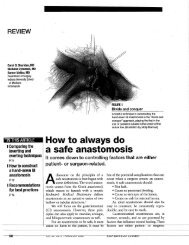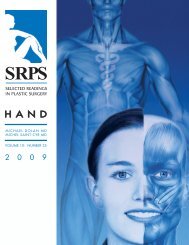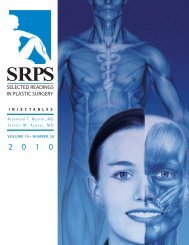Craniofacial Anomalies, Part 2 - Plastic Surgery Internal
Craniofacial Anomalies, Part 2 - Plastic Surgery Internal
Craniofacial Anomalies, Part 2 - Plastic Surgery Internal
Create successful ePaper yourself
Turn your PDF publications into a flip-book with our unique Google optimized e-Paper software.
Fig 5. (Above) The nose and upper lip in maxillonasal dysplasia.<br />
1 - Retracted columella-lip junction and lack of triangular flare at<br />
the base. 2 - Perpendicular alar-cheek junction. 3 - Upper lip<br />
convex with wide, shallow philtrum. 4 - Crescent-shaped nostril<br />
without nostril sill. 5 - Low set and flat nasal tip. 6 - Cupid’s bow<br />
stretched and shallow. (Below) Surgical correction is by medial<br />
rotation of tissues on either side of the nasal midline. (Reprinted<br />
with permission from Holmstrom H: Clinical and pathologic<br />
features of maxillonasal dysplasia (Binder’s syndrome): significance<br />
of the prenasal fossa on etiology. Plast Reconstr Surg<br />
78:559, 1986.)<br />
a coronal incision and reaching the nasal floor through<br />
an incision in the upper buccal sulcus. The nasal soft<br />
tissues and alar cartilages are mobilized. The nose is<br />
lengthened and tip projection is achieved with a cantilever<br />
graft of lyophilized cartilage.<br />
Wolfe 107 describes a technique of nasofrontal<br />
osteotomy to lengthen the nose in cases of posttraumatic<br />
shortening and Binder syndrome.<br />
McCollum 108 reviews the literature and provides long<br />
term follow up of 2 patients, one treated with traditional<br />
orthognathic surgery and the other with a<br />
growth center implant to the nose.<br />
PIERRE ROBIN SEQUENCE<br />
In 1923 Pierre Robin, a French stomatologist, noted<br />
a triad of characteristics of the upper airway which is<br />
now known as the Pierre Robin sequence. 109 The<br />
characteristic features consist of micrognathia,<br />
glossoptosis, and airway obstruction. 8,109 An associated<br />
high arched midline cleft of the soft palate and occasionally<br />
of the hard palate is present in approximately<br />
50% of cases. 110,111 The sequence shows great etiologic<br />
heterogeneity, with as many as 18 associated syndromes.<br />
The glossoptosis in Pierre Robin can begin a vicious<br />
sequence of events: airway obstruction, increased<br />
SRPS Volume 10, Number 17, <strong>Part</strong> 2<br />
Fig 6. Patient with Binder syndrome. A, B, at age 10. C, E,<br />
preoperatively at age 17. D, F, after orthodontic treatment (maxillary<br />
first bicuspid extractions), orthognathic surgery (Le Fort I osteotomy<br />
with horizontal advancement), and nasal reconstruction<br />
(corticocancellous iliac graft). (Reprinted with permission from<br />
Posnick JC, Tompson B: Binder syndrome: staging of reconstruction<br />
and skeletal stability and relapse patterns after Le Fort I osteotomy<br />
using miniplate fixation. Plast Reconstr Surg 99:967, 1997.)<br />
energy expenditure, and decreased caloric intake<br />
from impaired feeding. Afflicted infants typically fail<br />
to thrive because of respiratory and feeding difficulties.<br />
If these problems are ignored, respiratory failure,<br />
cardiac failure, and death may result.<br />
9






